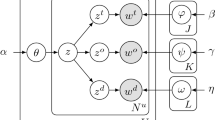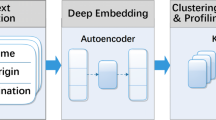Abstract
Understanding urban human mobility, particularly trip purposes, is essential for optimizing traffic management, personalized recommendations, and urban planning. However, in real-world scenarios, trip purposes cannot be directly extracted from the trajectory data. To address this issue, we propose a geometry-driven neural topic model for trip purpose inference. We integrate trajectory data with nearby POI data using a geometry-driven technique to enhance the interpretability of the results. Furthermore, our model captures the semantics and relationships of the data in a high-dimensional space and identifies latent topics representing distinct trip purposes. These learned topics are analyzed using clustering algorithms to group similar trips, enabling trip purpose inference. And we evaluate our model using the trajectory data of Shenzhen and Chengdu, and compare it with baseline models. The results demonstrate that our model performs well. Furthermore, we analyze trajectory data containing trip purpose information to gain insight into human mobility patterns and the influence of trip purposes, paving the way for potential implications and future research directions.













Similar content being viewed by others
Availability of Data and materials
This paper did not report any data and materials
References
Zheng Y, Capra L, Wolfson O, Yang H (2014) Urban computing: concepts, methodologies, and applications. ACM Trans Intell Syst Technol (TIST) 5(3):1–55
Wang P, Fu Y, Liu G, Hu W, Aggarwal C (2017) Human mobility synchronization and trip purpose detection with mixture of hawkes processes. In: Proceedings of the 23rd ACM SIGKDD International Conference on Knowledge Discovery and Data Mining, pp. 495–503
Faroqi H, Mesbah M (2021) Inferring trip purpose by clustering sequences of smart card records. Transportation Res Part C: Emerg Technol 127:103131
Jiang R, Cai Z, Wang Z, Yang C, Fan Z, Chen Q, Tsubouchi K, Song X, Shibasaki R (2021) Deepcrowd: A deep model for large-scale citywide crowd density and flow prediction. IEEE Trans Knowl Data Eng 35(1):276–290
Yuan J, Zheng Y, Xie X (2012) Discovering regions of different functions in a city using human mobility and pois. In: Proceedings of the 18th ACM SIGKDD International Conference on Knowledge Discovery and Data Mining, pp. 186–194
Zheng Y, Liu L, Wang L, Xie X (2008) Learning transportation mode from raw gps data for geographic applications on the web. In: Proceedings of the 17th International Conference on World Wide Web, pp. 247–256
Shao E, Wang H, Feng J, Xia T, Yang H, Geng L, Jin D, Li Y (2021) Deepflowgen: Intention-aware fine grained crowd flow generation via deep neural networks. IEEE Trans Knowl Data Eng 34(12):5693–5707
Deng J, Chen X, Jiang R, Song X, Tsang IW (2021) St-norm: Spatial and temporal normalization for multi-variate time series forecasting. In: Proceedings of the 27th ACM SIGKDD Conference on Knowledge Discovery & Data Mining, pp. 269–278
Gonzalez MC, Hidalgo CA, Barabasi AL (2008) Understanding individual human mobility patterns. Nature 453(7196):779–782
Wang D, Pedreschi D, Song C, Giannotti F, Barabasi A-L (2011) Human mobility, social ties, and link prediction. In: Proceedings of the 17th ACM SIGKDD International Conference on Knowledge Discovery and Data Mining, pp. 1100–1108
Song C, Koren T, Wang P, Barabási A-L (2010) Modelling the scaling properties of human mobility. Nature Phys 6(10):818–823
Yuan J, Zheng Y, Xie X, Sun G (2011) Driving with knowledge from the physical world. In: Proceedings of the 17th ACM SIGKDD International Conference on Knowledge Discovery and Data Mining, pp. 316–324
Miller HJ, Bridwell SA (2009) A field-based theory for time geography. Annals Assoc Am Geographers 99(1):49–75
Pelekis N, Kopanakis I, Kotsifakos EE, Frentzos E, Theodoridis Y (2011) Clustering uncertain trajectories. Knowl. Inf Syst 28:117–147
Zheng Y, Xie X, Ma W-Y et al (2010) Geolife: A collaborative social networking service among user, location and trajectory. IEEE Data Eng Bull 33(2):32–39
Zhou C, Frankowski D, Ludford P, Shekhar S, Terveen L (2007) Discovering personally meaningful places: An interactive clustering approach. ACM Trans Inf Syst (TOIS) 25(3):12
Ying JJ-C, Lu EH-C, Lee W-C, Weng T-C, Tseng VS (2010) Mining user similarity from semantic trajectories. In: Proceedings of the 2nd Acm Sigspatial International Workshop on Location Based Social Networks, pp. 19–26
Feng J, Li Y, Zhang C, Sun F, Meng F, Guo A, Jin D (2018) Deepmove: Predicting human mobility with attentional recurrent networks. In: Proceedings of the 2018 World Wide Web Conference, pp. 1459–1468
Zhao K, Musolesi M, Hui P, Rao W, Tarkoma S (2015) Explaining the power-law distribution of human mobility through transportationmodality decomposition. Sci Reports 5(1):1–7
Jiang R, Song X, Fan Z, Xia T, Wang Z, Chen Q, Cai Z, Shibasaki R (2021) Transfer urban human mobility via poi embedding over multiple cities. ACM Trans Data Sci 2(1):1–26
Song X, Zhang Q, Sekimoto Y, Shibasaki R, Yuan NJ, Xie X (2016) Prediction and simulation of human mobility following natural disasters. ACM Trans Intell Syst Technol 8(2). https://doi.org/10.1145/2970819
Fan Z, Song X, Liu Y, Zhang Z, Yang C, Chen Q, Jiang R, Shibasaki R (2020) Human mobility based individual-level epidemic simulation platform. SIGSPATIAL Special 12(1):34–40. https://doi.org/10.1145/3404820.3404826
Song X, Zhang Q, Sekimoto Y, Shibasaki R (2014) Prediction of human emergency behavior and their mobility following large-scale disaster. In: Proceedings of the 20th ACM SIGKDD International Conference on Knowledge Discovery and Data Mining, pp. 5–14
Jurdak R, Zhao K, Liu J, AbouJaoude M, Cameron M, Newth D (2015) Understanding human mobility from twitter. PloS one 10(7):0131469
Hawelka B, Sitko I, Beinat E, Sobolevsky S, Kazakopoulos P, Ratti C (2014) Geolocated twitter as proxy for global mobility patterns. Cartography Geographic Inf Sci 41(3):260–271
Pas EI, Koppelman FS (1987) An examination of the determinants of day-to-day variability in individuals’ urban travel behavior. Transportation 14(1):3–20
Stopher PR, Greaves SP (2007) Household travel surveys: Where are we going? Transportation Res Part A: Policy Pract 41(5):367–381
Gao G, Wang Z, Liu X, Li Q, Wang W, Zhang J (2019) Travel behavior analysis using 2016 qingdao’s household traffic surveys and baidu electric map api data. J Adv Transportation 2019
Zheng VW, Zheng Y, Xie X, Yang Q (2010) Collaborative location and activity recommendations with gps history data. In: Proceedings of the 19th International Conference on World Wide Web, pp. 1029–1038
Yao H, Wu F, Ke J, Tang X, Jia Y, Lu S, Gong P, Ye J, Li Z (2018) Deep multi-view spatial-temporal network for taxi demand prediction. In: Proceedings of the AAAI Conference on Artificial Intelligence, vol. 32
Blei DM, Ng AY, Jordan MI (2003) Latent dirichlet allocation. J Mach Learn Res 3(Jan):993–1022
Kingma DP, Welling M, et al. (2019) An introduction to variational autoencoders. Foundations Trends® Mach Learn 12(4):307–392
Blei DM, Kucukelbir A, McAuliffe JD (2017) Variational inference: A review for statisticians. J Am Stat Assoc 112(518):859–877
Mikolov T, Sutskever I, Chen K, Corrado GS, Dean J (2013) Distributed representations of words and phrases and their compositionality. Adv Neural Inf Process Syst 26
Guo Y, Liao W, Wang Q, Yu L, Ji T, Li P (2018) Multidimensional time series anomaly detection: A gru-based gaussian mixture variational autoencoder approach. In: Asian Conference on Machine Learning, pp. 97–112. PMLR
Srivastava A, Sutton C (2017) Autoencoding variational inference for topic models. arXiv:1703.01488
Kingma DP, Ba J (2014) Adam: A method for stochastic optimization. arXiv:1412.6980
Jacobi C, Van Atteveldt W, Welbers K (2018) Quantitative analysis of large amounts of journalistic texts using topic modelling. In: Rethinking Research Methods in an Age of Digital Journalism, pp. 89–106. Routledge, ???
Röder M, Both A, Hinneburg A (2015) Exploring the space of topic coherence measures. In: Proceedings of the Eighth ACM International Conference on Web Search and Data Mining, pp. 399–408
Van der Maaten L, Hinton G (2008) Visualizing data using t-sne. J Mach Learn Res 9(11)
Funding
This work was partially supported by the Grants of National Key Research and Development Program of China (2021YFB1714400), Guangdong Provincial Key Laboratory (2020B121201001), and the Grant in-Aid for Scientific Research B (22H03573) of Japan Society for the Promotion of Science (JSPS)
Author information
Authors and Affiliations
Contributions
Jiaqi Zhang and Zipei Fan wrote the main manuscript text. All authors reviewed the manuscript
Corresponding authors
Ethics declarations
Competing Interests
The authors have no competing interests to declare that are relevant to the content of this article
Additional information
Publisher's Note
Springer Nature remains neutral with regard to jurisdictional claims in published maps and institutional affiliations.
Rights and permissions
Springer Nature or its licensor (e.g. a society or other partner) holds exclusive rights to this article under a publishing agreement with the author(s) or other rightsholder(s); author self-archiving of the accepted manuscript version of this article is solely governed by the terms of such publishing agreement and applicable law.
About this article
Cite this article
Zhang, J., Fan, Z., Song, X. et al. A geometry-driven neural topic model for trip purpose inference. Geoinformatica 28, 313–333 (2024). https://doi.org/10.1007/s10707-023-00504-6
Received:
Revised:
Accepted:
Published:
Issue Date:
DOI: https://doi.org/10.1007/s10707-023-00504-6




